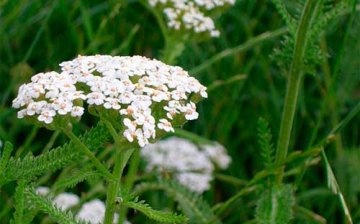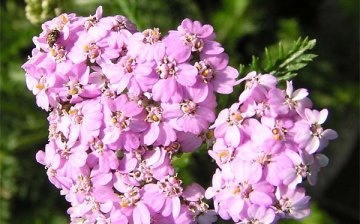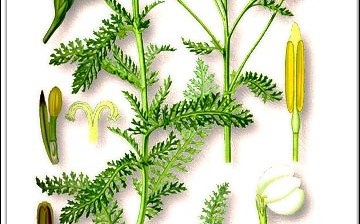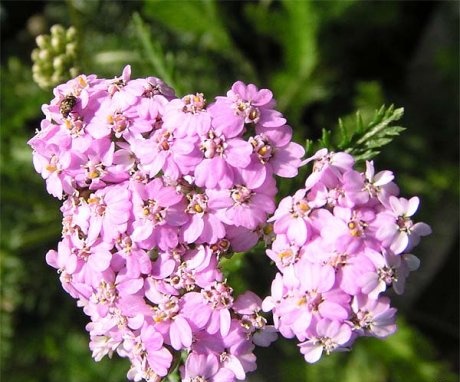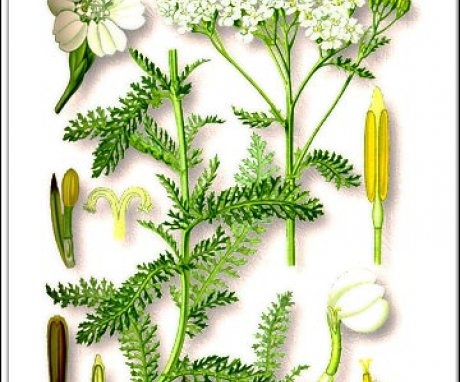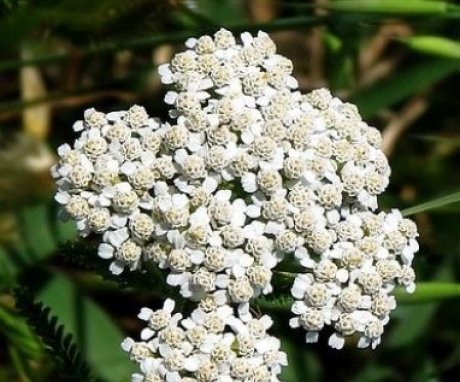Yarrow in the photo and its beneficial properties
Yarrow belongs to the Asteraceae family. It is a perennial herb. Examining the yarrow in the photo, you can see that its stem is pubescent, and the leaves are lanceolate in shape, thinly dissected, which gave the name to the Russian name for the plant.
Content:
- Spreading
- Collection of medicinal raw materials
- Chemical composition
- Useful properties of the plant
- Treatment of diseases with yarrow
- Yarrow in cosmetology
- Yarrow in cooking
- Contraindications
The origin of the Latin name is explained by ancient Greek mythology. There is a legend that tells that Achilles with the help of a yarrow healed the wounded Telephus, the son of Hercules. In honor of Achilles, the plant was named Achillea millefolium.
Yarrow plants with white flowers are more common, but there are flowers with pink, red and yellow colors. Flowering begins in June and lasts until the end of summer.
Spreading
The distribution area of yarrow is all over Russia, Central Asia and the Far East. The favorite places for the growth of the plant are forest edges, forest glades, roadsides and fields, meadows and steppe spaces. You can often find it in settlements, gardens and parks. Yarrow prefers lighted, weed-free places, but grows well in partial shade.
Collection of medicinal raw materials
How medicinal raw materials are used grass yarrow, which is harvested during the flowering period by cutting off the tops of plants with leaves about 15 centimeters long.
Dry the plant in the shade. It is not recommended to store dry raw materials for more than 2 years.
Chemical composition
The herb of the plant contains carotene, vitamins C and K, tannins, essential oils, resins, phytoncides, organic acids and trace elements.
Traditional medicine has long been widely used healing properties plants. Extracts, infusions and decoctions are prepared from it. Use and the juice yarrow.
Useful properties of the plant
In medicine and folk treatment, the beneficial properties of yarrow as a hemostatic plant are known. Even in ancient times, it was used to treat various wounds. To do this, the leaves of the yarrow were applied to the wounds or squeezed juice was sprinkled on non-healing wounds.
It is known that soldiers serving in the Suvorov army must have carried with them a powder made from the herb of yarrow. It was used to cover wounds and save from amputation and gangrene.
It is customary to use the hemostatic properties of yarrow for gastrointestinal, hemorrhoidal, nasal, pulmonary, uterine bleeding, heavy menstruation and bleeding of the gums. The infusion of the plant is used to increase blood clotting and reduce the risk of blood clots.
The yarrow in the photo still bears the popular name "bloodstone", which clearly describes its main purpose.
The plant has many more popular names indicating its use. It is called the yarrow of the knights, the grass of soldiers' wounds, the grass of war, the grass of blood, the consumptive grass, the tenacious grass, the porridge, the ore grass, the soldier's purse, the woodworm, the grass of St. Joseph.
But not only hemostatic properties are famous for yarrow.Also known are the antibacterial, anti-inflammatory, bactericidal, anti-allergic and antispasmodic properties of the plant.
Treatment of diseases with yarrow
Yarrow also helps with burns. In addition, the plant is able to reduce the frequency of heart rate and vasodilatation.
It is very beneficial to take infusion yarrow to improve the digestive process. It affects the improvement of appetite, helps in the treatment of gastritis, liver diseases, gastric ulcer and duodenal ulcer, dysentery, flatulence, urinary incontinence.
Yarrow is also used as an expectorant for bronchopulmonary diseases due to its anti-inflammatory effect.
He cures malaria, kidney stones, colds, anemia, expels worms, increases lactation. Yarrow has a beneficial effect on nervous diseases: migraines, hysteria, hypochondria.
Toothache and inflammation in the oral cavity will recede if you use water infusions of yarrow for rinsing. They will also be effective in enemas for hemorrhoids.
Due to its choleretic and diuretic effect, yarrow has an excellent effect on obesity.
Yarrow baths treat skin diseases. For the treatment of cutaneous tuberculosis, fistula and ulcers, plant sap is used. Yarrow juice in combination with honey is used as a general tonic.
Yarrow in cosmetology
Yarrow is also used in cosmetology. It removes dry skin, moisturizes and nourishes it. It has an effective effect on fragility, hair loss and graying, dryness, keratinization and flaking of the scalp. Infusion of yarrow makes hair strong and healthy, gives it shine and volume.
Yarrow in cooking
Yarrow was also used in cooking as a fragrant seasoning. And brewers substituted them for hops in the production of beer.
Contraindications
You should know that it is not recommended to use yarrow for people with increased blood clotting and prone to thrombosis. It is contraindicated during pregnancy and with individual intolerance. Do not give it to small children.
Long-term use of preparations from the plant can lead to skin rashes, nausea and dizziness.



